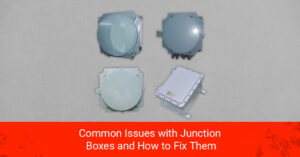This blog will help you understand the markings observed on IECEx flameproof equipments.
The use of electrical equipment can be dangerous in a potentially hazardous environment containing flammable gases, dust, liquids, fibres, or vapors. Thus, it is necessary to minimise the potential for fire or explosion in such a situation.
One way to prevent danger is utilising equipment that has been approved as suitable for that environment and is unlikely to cause a fire or explosion. Equipment intended for use in hazardous sites must be certified in accordance with ATEX directives in the European Union, whereas certification is normally carried out using the IECEx system in other regions of the world.
What is the ATEX Directive?
ATEX is the European regulatory framework for production, installation, and use of equipment in explosive environments. The ATEX framework consists of two directives:
The ATEX Workplace Directive 1999/92/EC (commonly known as ATEX 137) is concerned with the health and safety of workers in potentially explosive environments. It largely relates to employers and also covers the selection, installation, inspection and maintenance of equipment in explosive environments.
In 2016, the original directive 94/9/EC was replaced by the ATEX Equipment Directive 2014/34/EU (commonly known as ATEX 114). It is applicable to equipment manufacturers and also outlines crucial health and safety regulations as well as conformity assessment processes that must be followed before products can be supplied to the EU market.
The ATEX directives are legally mandated for both electrical and non-electrical equipment marketed or placed in the EU market, that may be used in potentially hazardous atmospheres.
What is the IECEx Directive?
The international electrotechnical commission for certification to standards relating to equipment for use in explosive environments, or the IECEx was essentially created to simplify the worldwide trade of equipment used in potentially hazardous environments while retaining the required level of safety.
IECEx facilitates international trade by deducting manufacturers’ testing and certification costs and time to the market, encouraging international confidence in the product evaluation process and the services/equipment covered by the IECEx certification, and also by providing one international database lining.
Unlike ATEX that applies to both electrical and non-electrical equipment, IECEx applies only to electrical environments to be used in potentially explosive atmospheres. Additionally, IECEx employs more stringent criteria for proof during the certification procedure.
Classification of ATEX and IECEx Markings
The ATEX and IECEx certifications align with the iEC 60079 standards. In terms of technical specifications, there is little difference between them. The marking systems of ATEX and IECEx, thus, are quite similar, and the two markings are frequently combined. Let us break down the ATEX/IECEx markings and understand what each component means:
- Explosion Protection
The EX in the marking demonstrates the equipment is explosion protected. The equipment can be used in potentially hazardous environments containing vapors, dust, ignitable or explosive gases and flyings. The equipment is designed to particularly ensure no explosions take place and if at all one occurs, it cannot spread to the hazardous atmospheres.
- European Detective
The CE mark shows that the producer has evaluated the product and determined that it complies with EU safety, health, and environmental protection standards. The Notified Body Number is displayed on this symbol. (The notified body is a company tasked with evaluating the conformance of goods before they are marketed in the EU.)
- Equipment Group
Whether the equipment can be used in mines or in all other areas is distinguished by equipment group.
- Group I consists of mining equipment in environments with methane gas and coal dust.
- Group II consists of equipment used in above-ground explosive environments with gases, vapors, or mist. The three sub-groups are:
– Group IIA for gases like propane
– Group IIB for gases like ethylene
– Group IIC for gases like hydrogen, acetylene
- Group III consists of equipment used in above-ground explosive environments with dust or flyings. The three sub-groups are:
– Group IIIA for flyings
– Group IIIB for non-conducive dust
– Group IIIC for conducive dust
- Equipment Category
The equipment’s category is determined by the hazardous location Zone in which it is to be utilised. Lower equipment category numbers indicate the need for greater ignition protection.
- M1 and M2 are categories for mining equipment.
- Category 1 is for equipment to be used in Zones 0 (gas) or 20 (dust)
- Category 2 is for equipment used in Zones 1 (gas) or 21 (dust)
- Category 3 is for equipment used in Zones 2 (gas) or 22 (dust)
- Environment
Environment represents whether the atmosphere contains gases, mist, vapors or dust hazardous in nature. “G” stands for gases, mist or vapors and “D” stands for dust or flyings.
- Equipment Protection Level
EPL identifies the level of protection a device offers. It is based on estimating the likelihood of a flammable environment and the danger of an ignition source forming on the device. Generally required only for IECEx marking, the equipment protection level comprises an uppercase letter G (gas) or D (dust), along with a lowercase letter that indicates the hazardous location Zone in which the equipment is permitted to be used.
Levels Ga and Da are suitable for Zones 0 and 20.
Levels Gb and Db are suitable for Zones 1 and 21.
Levels Gc and Dc are suitable for Zones 2 and 22.
Conclusion
We hope this blog has helped you understand the markings on IECEx equipment. You can check out our offerings if you are looking to procure products for your company.
Bharat Flameproof is a leading manufacturer of flameproof and explosion-proof products in India. Our range of products are:
5. Flameproof distribution board
and much more







